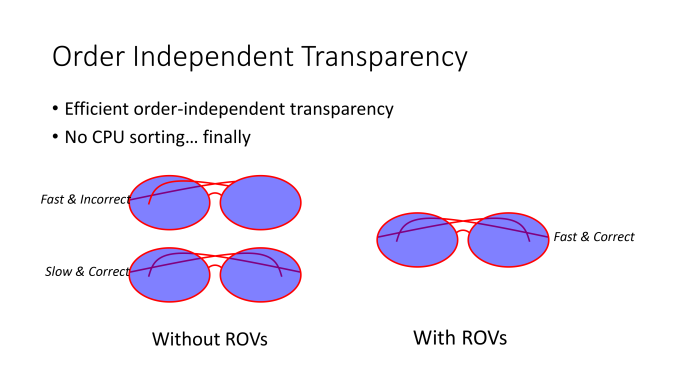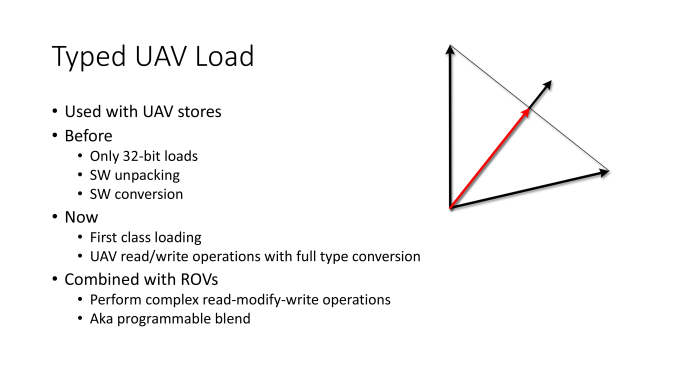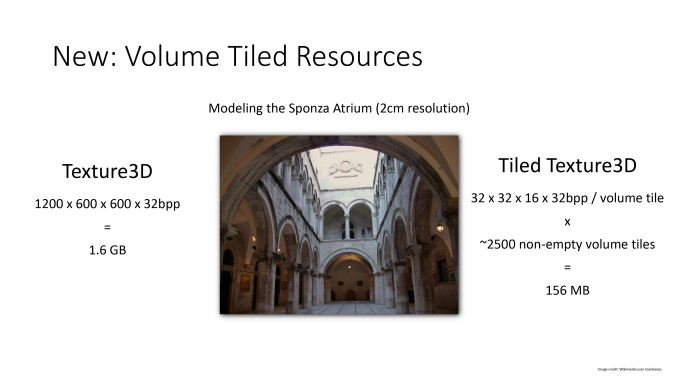Me he molestado en mirar una página que no se que reputación tendrá, pero me suena bastante
Pone que estas son las que llegarán
a 11.3
y 12. Suponen que habrá mas cosas pero que
aún no las han dicho, o eso he entendido que dicen

. Entre ellas esta lo que comentaba Polyeteres del Volume Tiled Resources.
Fuente:
http://www.anandtech.com/show/8544/micr ... w-features11.3 & 12: New Features
Getting to the heart of today’s announcement from Microsoft, we have the newly announced features that will be coming to Direct3D 11.3 and 12. It should be noted at this point in time this is not an exhaustive list of all of the new features that we will see, and Microsoft is still working to define
a new feature level to go with them (in the interim they will be accessed through cap bits), but none the less this is our first detailed view at what are expected to be the major new features of 11.3/12
Rasterizer Ordered Views
First and foremost of the new features is Rasterizer Ordered Views (ROVs). As hinted at by the name, ROVs is focused on giving the developer control over the order that elements are rasterized in
a scene, so that elements are drawn in the correct order. This feature specifically applies to Unordered Access Views (UAVs) being generated by pixel shaders, which buy their very definition are initially unordered. ROVs offers an alternative to UAV's unordered nature, which would result in elements being rasterized simply in the order they were finished. For most rendering tasks unordered rasterization is fine (deeper elements would be occluded anyhow), but for
a certain category of tasks having the ability to efficiently control the access order to
a UAV is important to correctly render
a scene quickly.

The textbook use case for ROVs is Order Independent Transparency, which allows for elements to be rendered in any order and still blended together correctly in the final result. OIT is not new – Direct3D 11 gave the API enough flexibility to accomplish this task – however these earlier OIT implementations would be very slow due to sorting, restricting their usefulness outside of CAD/CAM. The ROV implementation however could accomplish the same task much more quickly by getting the order correct from the start, as opposed to having to sort results after the fact.
Along these lines, since OIT is just
a specialized case of
a pixel blending operation, ROVs will also be usable for other tasks that require controlled pixel blending, including certain cases of anti-aliasing.
Typed UAV Load

The second feature coming to Direct3D is Typed UAV Load. Unordered Access Views (UAVs) are
a special type of buffer that allows multiple GPU threads to access the same buffer simultaneously without generating memory conflicts. Because of this disorganized nature of UAVs, certain restrictions are in place that Typed UAV Load will address. As implied by the name, Typed UAV Load deals with cases where UAVs are data typed, and how to better handle their use.
Volume Tiled Resources

The third feature coming to Direct3D is Volume Tiled Resources. VTR builds off of the work Microsoft and partners have already done for tiled resources (AKA sparse allocation, AKA hardware megatexture) by extending it into the 3rd dimension.
VTRs are primarily meant to be used with volumetric pixels (voxels), with the idea being that with sparse allocation, volume tiles that do not contain any useful information can avoid being allocated, avoiding tying up memory in tiles that will never be used or accessed. This kind of sparse allocation is necessary to make certain kinds of voxel techniques viable.
Conservative Rasterization

Last but certainly not least among Direct3D’s new features will be conservative rasterization. Conservative rasterization is essentially
a more accurate but performance intensive solution to figuring out whether
a polygon covers part of
a pixel. Instead of doing
a quick and simple test to see if the center of the pixel is bounded by the lines of the polygon, conservative rasterization checks whether the pixel covers the polygon by testing it against the corners of the pixel. This means that conservative rasterization will catch cases where
a polygon was too small to cover the center of
a pixel, which results in
a more accurate outcome, be it better identifying pixels
a polygon resides in, or finding polygons too small to cover the center of any pixel at all. This in turn being where the “conservative” aspect of the name comes from, as
a rasterizer would be conservative by including every pixel touched by
a triangle as opposed to just the pixels where the tringle covers the center point.
Conservative rasterization is being added to Direct3D in order to allow new algorithms to be used which would fail under the imprecise nature of point sampling. Like VTR, voxels play
a big part here as conservative rasterization can be used to build
a voxel. However it also has use cases in more accurate tiling and even collision detection.
Final Words
Wrapping things up, today’s announcement of Direct3D 11.3 and its new features offers
a solid roadmap for both the evolution of Direct3D and the hardware that will support it. By confirming that they are continuing to work on Direct3D 11 Microsoft has answered one of the lingering questions surrounding Direct3D 12 – what happens to Direct3D 11 – and at the same time this highlights the hardware features that the next generation of hardware will need to support in order to be compliant with the latest D3D feature level. And with Direct3D 12 set to be released sometime next year, these new features won’t be too far off either.
Por completar podemos
añadir el test de Intel que mejoraba
un 50% la cpu de
un hardware que no es full compatible con directx12
fuente:
http://www.anandtech.com/show/8388/inte ... provementsLogicamente todo esto lo podremos ver en otras Apis, cuando sepan hacerlo
y lo programen, logicamente







 . Que si, que ya sabemos que sabes mucho .... pero tu no eres el único ingeniero del mundo .... que parece que si no lo sabes tu no lo sabe nadie
. Que si, que ya sabemos que sabes mucho .... pero tu no eres el único ingeniero del mundo .... que parece que si no lo sabes tu no lo sabe nadie ![más risas [+risas]](/images/smilies/nuevos/risa_ani3.gif) .
.![Que me parto! [qmparto]](/images/smilies/net_quemeparto.gif) si la mayoría no tendría ni puta idea de que eso es. Ésto solo se puede demostrar mediante juegos, así que habrá que esperar todavía un tiempo para ver si realmente xbox one es lo que se intuye y microsoft ha parido su consola con el api que estaba a la vuelta de la esquina en mente o se ha quedado a medias.
si la mayoría no tendría ni puta idea de que eso es. Ésto solo se puede demostrar mediante juegos, así que habrá que esperar todavía un tiempo para ver si realmente xbox one es lo que se intuye y microsoft ha parido su consola con el api que estaba a la vuelta de la esquina en mente o se ha quedado a medias. 
 . Entre ellas esta lo que comentaba Polyeteres del Volume Tiled Resources.
. Entre ellas esta lo que comentaba Polyeteres del Volume Tiled Resources.



